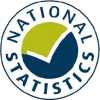Higher Education Student Statistics: UK, 2021/22 - Notes
- Summary
- Student numbers and characteristics
- Where students come from and go to study
- Subjects studied
- Qualifications achieved
- Notes
Who produced this Statistical Bulletin?
This bulletin has been produced by Jisc in collaboration with statisticians from the Department for Education, the Office for Students, the Welsh Government, the Scottish Government and the Department for the Economy Northern Ireland. It has been released according to the arrangements approved by the UK Statistics Authority.
HESA merged with Jisc in October 2022. Jisc was designated as a producer of official statistics in August 2023. Official and National Statistics which are now published by Jisc will continue to be published under the HESA brand. The data collection activity which delivers the data to support production of official statistics also continues to be undertaken under the HESA brand.
What is the coverage of data in this release?
There are notable changes to the coverage of Student data from 2019/20. Prior to 2019/20, we reported data about all publicly funded HE providers in the UK (and the University of Buckingham) and HE level provision at further education (FE) colleges in Wales, Higher Education Student Statistics: UK, 2018/19. This equated to all providers submitting data to the HESA Student record. A later supplement to the release added in separate additional tables and charts relating to data reported within the HESA Alternative provider student record (from 2019/20 this became known as the Student alternative record). From 2019/20 we have combined data from both records into the same tables and charts to coincide with regulatory changes in England that mean boundaries between the two HESA student records become less clear cut.
A notable change in England from 2019/20 was the introduction of the Office for Students (OfS) Register and the two types of registration categories available to providers in England; Approved (fee cap) and Approved. Providers in both registration categories are included in the Student and Student alternative records from this year. Further information relating to the OfS Register can be found in section III of the pdf document Securing student success: Regulatory framework for higher education in England (pdf).
Other coverage changes to be aware of include:
- Data about students and qualifiers from Ballet West have been excluded from historic years of data in this release. This HE provider located in Scotland chose to optionally return data to HESA (prior to merger with Jisc) for a number of years until 2018/19. Please note that data for this provider has been included in data previously published by HESA from the Alternative provider student record.
- Data for students enrolled on HE level courses at further education (FE) colleges in Wales have only been collected in the HESA Student record from 2016/17.
- Data was first collected for the Alternative provider student record in 2014/15. There have been several coverage changes to this record over the years, most notably in 2016/17 when Alternative Providers with degree awarding powers were first required to return data about students on Masters taught designated courses. Additionally in 2017/18 when all providers in the record were required for the first time to return postgraduates on both taught and research courses.
In relation to the Aggregate offshore record as used in Figure 12 of this release, there have been coverage changes worth noting this year as well. In 2018/19 and earlier years, the Aggregate offshore record included all publicly funded HE providers in the UK and the University of Buckingham. From 2019/20, coverage expanded to include all English providers registered with the Office for Students’ (OfS) in the Approved (fee cap) and Approved categories and all publicly funded HE providers in Wales, Scotland and Northern Ireland. In 2021/22, 174 HE providers reported aggregate offshore data to Jisc. This increased from 171 in 2020/21.
Also from 2019/20, additional data was required for the first time from HE providers in England and Wales to include students who were dormant for the entire reporting year. Students at HE providers in England and Wales who were dormant for the entire year have been excluded from this release, except in the circumstance that they successfully complete their course during the reporting year.
It should be noted that for many years Oxford Brookes had a very large population of offshore students. The provider changed their reporting practices for the 2019/20 academic year around which students they include in their Aggregate offshore return. This led to a drop of 256,450 students between 2018/19 and 2019/20 for this provider, resulting in a significant drop to the overall number of student enrolments based wholly overseas.
Where are subject data for older years?
In 2019/20 we transitioned our approach to presenting the subjects studied by students on courses from a previous standard (JACS) to the Higher Education Classification of Subjects (HECoS) vocabulary. A Common Aggregation Hierarchy (CAH) was produced to aid time-series analysis across both of these standards. We published our initial analysis showing how patterns of subject coding have changed during the transition. For a summary of how we reported this change, see the notes section of Higher Education Student Statistics: UK, 2020/21.
We are currently conducting a data-driven investigation into the use of a timeseries including both JACS and CAH. We plan to publish the results of this analysis in the first part of 2023.
Are there any other notable changes in this release?
This release contains data from the participation of local areas (POLAR) classification; a measure of relative HE participation across the UK. Some regions of the UK have traditionally high participation rates, including Scotland and Northern Ireland. Figures in these areas, when viewed in isolation could misrepresent the contribution being made to widening participation. For a number of years, HESA publications have for this reason excluded data for Scotland from POLAR figures (both where the country of HE provider or country of domicile is in Scotland).
In Northern Ireland, the Department for the Economy (Northern Ireland) recommend the use of the Northern Ireland Multiple Deprivation Measure (NIMDM) Quintiles as a more representative measure of educational disadvantage among these students. Although Northern Ireland data has historically been included in POLAR figures published by HESA, recognising the possibility for misrepresentation of this data coupled with the availability of NIMDM as an alternative in some HESA published tables from January 2019, Jisc has decided to remove Northern Ireland data from POLAR figures in all publications from January 2022.
Are any changes expected for future releases?
For the 2022/23 student data release, Jisc intends to use the Data Futures record as the source data (please see our Data Futures blog for more information). More information on publications using Data Futures will be released ahead of the next Student publication.
Has data for earlier years been revised?
This release uses revised data returns (the 'fixed' database) for time series figures. The fixed data return facility provides HE providers with the opportunity to make post-collection amendments to their HESA return. The fixed database remains open for between 6 and 15 months following the closure of the corresponding live data collection and usually becomes available at least 18 months after the original dataset is delivered. Please refer to the definitions below for detail as to which versions have been used to produce this release and the impact of these changes.
Has COVID-19 had any impact on this release?
The outbreak of the COVID-19 pandemic was declared by the World Health Organisation in March 2020, just over half way through the 2019/20 academic year. An insight brief has been published that analyses the impact of the pandemic on student data and trends across years of enrolments and qualifications across various characteristics.
The 2019/20 - 2021/22 data was collected during the COVID-19 pandemic. Exceptional guidance was issued to HE providers regarding a number of data fields within the collections to clarify Jisc's expectations about how these fields should be treated in light of the pandemic.
How to use the tables and charts
The tables and charts (labelled as figures) within this bulletin are interactive. There are options immediately above the figures to filter by data field(s) such as by first year marker or mode of study. The figures refresh to display the option(s) chosen, updating the data accordingly. The 'Reset filters' link below each figure will clear all selected options.
In the figures, 0, 1, 2 are rounded to 0. All other numbers are rounded up or down to the nearest multiple of 5 in line with the HESA rounding strategy. Percentages are calculated on unrounded data and are rounded to the nearest whole number. This means percentages may not sum exactly to 100%.
It is a criminal offence under Section 171 of the Data Protection Act 2018 for a person knowingly or recklessly to re-identify information that is de-identified personal data without the consent of the controller responsible for de-identifying the personal data.
How can I get the data in a spreadsheet?
All the data is presented in interactive tables on the HESA website and will not be published in Excel spreadsheets. Below each table you will find a link to download the table as a *.csv.
If you are planning to open the *.csv files in Excel, you must ensure you import the *.csv data, rather than just opening the file directly. This will ensure the data is presented appropriately without corrupt characters appearing. We have published instructions on how to import *.csv files in earlier versions of Excel. If you are using Excel 2016, you should select 'Data' in the top ribbon and then choose 'From Text/csv'. In the options screen, select '65001: Unicode (UTF-8)' in the 'File Origin' box; click 'Edit' and ensure that all columns are formatted as 'Text'.
How to print this bulletin
This bulletin is designed primarily for on screen users. However if you need to print it then each section of the release can be printed by hitting Ctrl+P from within a section.
How are Open University students counted?
As in previous years of this release, enrolments and qualifications registered at one of The Open University's (OU) national centres in Wales, Scotland and Northern Ireland will contribute to the totals of those countries where statistics are shown by country of HE provider. Please note that all non-UK domiciled OU students, those who study at postgraduate research level, and students returned in the Aggregate offshore record, are registered to the OU administrative centre in England.
National Statistics
The UK Statistics Authority (UKSA) designated these statistics as National Statistics, in accordance with the Statistics and Registration Service Act 2007 and signifying compliance with the Code of Practice for Statistics. A compliance check undertaken by the Office for Statistics Regulation (OSR) in December 2018 confirmed that these statistics can continue to be designated as National Statistics.
Designation can be broadly interpreted to mean that the statistics:
- are of public value
- are of high quality; and
- are produced by departments and public bodies that can be trusted.
Once statistics have been designated as National Statistics it is a statutory requirement that the Code of Practice shall continue to be observed.
Where can I find more detail on students in higher education?
Our Higher Education Student Data, 2021/22 open data release will be published on 31 January 2023. This will provide more detailed information about students in higher education in the UK.
Definitions
The data presented in this bulletin is based on the 2021/22 HESA Student, Student alternative and Aggregate offshore records. The statistics in this bulletin are derived by Jisc from data collected from all publicly funded HE providers in Wales, Scotland and Northern Ireland, both Approved (fee cap) and Approved HE providers in England, and FE colleges in Wales.
Student enrolments and qualifications data was prepared in January 2023 using the following versions of the datasets:
HESA Student record
- 2012/13 Fixed dataset, September 2016 version
- 2013/14 Fixed dataset, February 2018 version
- 2014/15 Fixed dataset, March 2018 version
- 2015/16 Fixed dataset, June 2019 version
- 2016/17 Original dataset, November 2017 version
- 2017/18 Original dataset, February 2021 version
- 2018/19 Original dataset, November 2020 version
- 2019/20 Original dataset, September 2022 version
- 2020/21 Original dataset, December 2021 version
- 2021/22 Original dataset, November 2022 version
HESA Student alternative record
- 2015/16 Fixed dataset, October 2019 version
- 2016/17 Original dataset, January 2018 version
- 2017/18 Original dataset, January 2020 version
- 2018/19 Original dataset, November 2020 version
- 2019/20 Original dataset, November 2020 version
- 2020/21 Original dataset, November 2021 version
- 2021/22 Original dataset, November 2022 version
Student enrolments and qualifications definitions
- Coverage
- Fixed database
- Standard registration population
- Qualifications obtained population
- Rounding strategy
- Age
- Country/Region of HE provider
- Class of first degree
- Disability status
- Ethnicity
- HE provider identifiers
- Level of study/Qualification obtained
- Low-participation neighbourhoods (POLAR4)
- Mode of study/qualification
- Parental education
- Permanent address / domicile
- Sex
- Socio-economic classification
- State school marker
- Subject of study
- Year of study/first year marker
See data intelligence for specific notes about this year's student data.
Aggregate offshore definitions
See data intelligence for specific notes about this year's aggregate offshore data return.
Jisc cannot accept responsibility for any inferences or conclusions derived from the data by third parties.
Contact Us
Press enquiries should be directed to the HESA Press Office, 95 Promenade, Cheltenham, GL50 1HZ, +44 (0) 1242 388 513 (option 6), [email protected]. General enquiries about the data contained within this bulletin should be addressed to Rebecca Mantle, Head of Official Statistics, Jisc (at the same address), +44 (0) 1242 388 513 (option 2), [email protected].

Release date
19 January 2023, 9:30
Coverage
UK
Release frequency
Annual - view all releases (1998/99 onwards)
Themes
Children, education and skills
Issued by
HESA, 95 Promenade, Cheltenham, GL50 1HZ
Press enquiries
+44 (0) 1242 388 513 (option 6), [email protected]
Public enquiries
+44 (0) 1242 388 513 (option 2), [email protected]
Statistician
Rebecca Mantle
Pre-release access
View pre-release access list for this release





